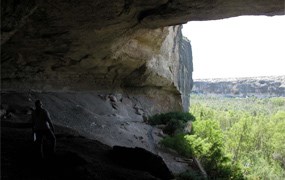
NPS Photo Nestled along the United States-Mexico border in southwestern Texas and northwestern Coahuila, the Lower Pecos River Archeological region encompasses an area of about 7,900 square miles. Though this cultural region is fairly small, more than 2,000 archeological sites have been recorded. These sites cover a time span from the 19th century to over 10,000 years ago. Over 325 pictograph sites have been documented containing some of North America’s oldest and largest pictographs (rock paintings). These pictographs range in size from isolated motifs just a few inches tall to huge panels stretching more than 100 feet along the back of rock shelter walls. For readers unfamiliar with the region or for those who want more in-depth information about archeological and historical sites throughout Texas, be sure to visit www.texasbeyondhistory.net. 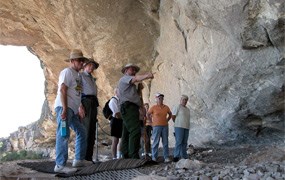
NPS Photo Seminole Canyon State Park & Historic Site, located nine miles west of Comstock, Texas, on Highway 90, offers rock art connoisseurs one of the most complete venues in the region featuring a bookstore, campground, and interpretive center. Guided tours are offered to the Fate Bell and Fate Bell Annex pictograph sites. Contact the park for current tour schedules and fees. In 2006, more than 4,500 visitors took this one-hour hiking tour. Additional guided tours to remote sites in the park are offered on an irregular basis for a nominal fee and require advance registration. Those willing to brave the eight hours of very strenuous hiking and climbing on the Presa Canyon Tour are rewarded with the rare opportunity to visit several of the park’s pictograph sites which are normally closed to the public. Another of the parks irregularly offered tours, known as the Upper Canyon tour, takes about two hours of moderate hiking and includes stops at two pictograph sites and several 19th century railroad sites. Those planning a trip to Seminole Canyon should call (432) 292-4464 for more information. 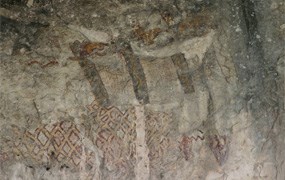
NPS Photo The National Park Service manages over 540 miles of shoreline on the U.S. side of the International Amistad Reservoir. Amistad National Recreation Area has two major pictograph sites open for public visitation; Panther Cave (which is jointly managed with Seminole Canyon State Park) and Parida Cave. Both sites were developed years ago and are intended to provide boaters with recreational opportunities that compliment Seminole Canyon’s land-based activities. A note to visitors: In recent years, regional droughts have resulted in lowered lake levels, sometimes by more than fifty vertical feet. As a result, there have been times when both Parida and Panther Caves have been closed to boaters because of dangerous river conditions on the upper part of the reservoir. Anyone wishing to visit either site should check lake conditions prior to making a trip by calling the Amistad National Recreation Area Visitor Center at (830) 775-7491. 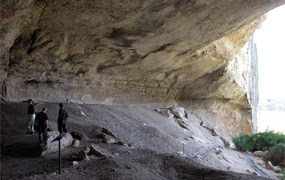
NPS Photo Parida Cave, once known as "Painted Caves Station," was a welcome stop for travelers riding on the Southern Pacific’s transcontinental railroad in the 1880s and early 1890s. Though the station was only open for nine years, from 1883 to 1892, travelers had already painted graffiti over and adjacent to the prehistoric pictographs at the site. National Park Service excavations in 1967 revealed that, though horribly looted, the site still had deeply stratified and well-preserved archeological materials, portions of which date back more than 5,000 years. Today, Parida Cave’s expansive interior features more than 300 feet of designated trails, interpretive signage, and an unparalleled opportunity to experience the sights and sounds of a remote prehistoric rock shelter. A boat dock provides access to the site but may be removed at low water levels. Check conditions before making a trip by calling Amistad National Recreation Area Visitor Center at (830) 775-7491. 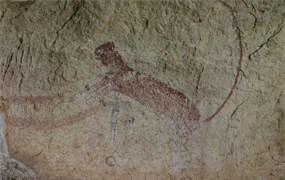
NPS Photo Panther Cave is the region’s most famous pictograph site. The rear wall of the shelter is covered floor to ceiling with hundreds of motifs which collectively form an uninterrupted panel more than 100 feet in length. The namesake of the site is a giant, red-painted panther (also called a mountain lion) that is over ten feet long from nose to the tip of the tail. Visitors should check lake conditions prior to making a trip by calling the Amistad Visitor Center at (830) 775-7491. Low lake levels can prevent access through the mouth of the Pecos from the Pecos boat ramp (14 miles round trip). The next closest boat ramp is Box Canyon (60 miles round trip). From the boat dock at Panther Cave, visitors climb a sixty-foot steel staircase up to the rock shelter. A steel fence and an elevated catwalk limit where visitors can walk to reduce potential damage to vegetation and buried archeological remains. The steel fence protecting the site is designed to maximize photographic vantage points while preventing damage to the pictographs. Unobtrusive interpretive panels provide visitors with information about the pictographs, the prehistoric cultures that once lived in the reservoir basin, and the need to protect and preserve Panther Cave and related sites in the region. 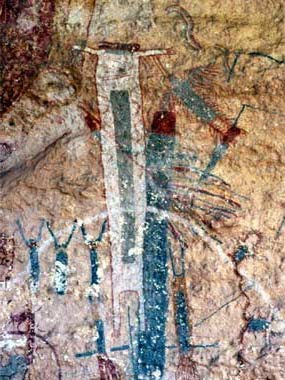
NPS Photo From fall to spring, the Witte Museum leads weekly tours to the White Shaman Preserve, which overlooks the Pecos River two miles west of Seminole Canyon State Park. The White Shaman mural, which was painted thousands of years ago, is thought to illustrate a complex story of the lifeways, beliefs, and spirituality of the first indigenous people of what we now call Texas. The Witte Museum also offers periodic trips to other significant sites in the Lower Pecos Canyonlands Archaeological District. “Know Before You Go” is key for anyone wanting to see the pictographs of the Lower Pecos region of southwest Texas. While opportunities are plentiful, lake levels, tour availability and location, and weather may prevent you from visiting these sites at the time of your visit. So, research what is available and plan ahead. Seminole Canyon State Park & Historic Site is a sure bet if you have little time or are just passing through the area. For heartier folks, Presa Canyon and Upper Canyon tours offer the experience of a lifetime. If you have or are renting a boat, the Panther Cave and Parida Cave trip provides the best that the region has to offer--provided the reservoir water level is high enough to make the sites accessible. Or, you can join one of the regional rock art foundations and make annual treks to participate in sponsored activities for many years to come. No matter what you choose to do be sure to check local web sites first to ensure that “you know before you go.” Open Transcript Open Descriptive Transcript TranscriptThis video does not include sound. A distant look across the lake at a cliff identified as Panther Cave. Upon zooming in, a dock and several steep, metal staircases with handrails going up the rocky cliff are visible. We gradually continue to zoom into the rock shelter or cave at the top of the stair cases. There is a fence that goes from the top of the rock shelter all the way to the bottom and covers the sides. A gate is open on the side closest to us and backpacks line the metal walkway in front of the rock shelter. There are five people, some sitting and some standing, inside the fenced off area. Switching to a computer-enhanced, 3D image of the cave, the fence fades away giving an unobstructed view of the computer image. Low lying slabs of rock litter the back and the middle of the cave with a level walkway aound the center pile. On the far wall is a red, painted panther with a very long tail. The computer image slowly zooms in and rotates to provide a view of the rock shelter wall nearest where the gate was. The panning and zooming of the image stops where a large panel of faint, red paintings are obvious but difficult to interpret. The picture contrast and color are brightened greatly and identified as "enhancement". Standing out among the red paintings, known as "pictographs", are a four-legged animal of some sort and a striped figure that may be humanoid with a squiggly line like a snake. The enhanced image fades back to the natural colors, and the image continues to pan to the right passing over other evident but faint, red and black pictographs. The panning stops among a group of pictographs. The enhancement here helps reveal what appears to be two animal-like creatures on four legs, with rounded bodies, running to the right with a tall humanoid-type figure behind them. While still in the enhanced mode, the image continues to pan to the right where three more of the round-bodied animals appear to be running the same direction as the first two. The panning stops, and the color fades back to the natural colors resulting in the last in the line of four-legged animals being very faint and difficult to make out once the image returns to its natural color state. The image slowly zooms out and pans upward. Fewer red or black pictographs are visible here. However, a very long one becomes evident and the image stops on it. With the enhancement, what appears to be a humanoid figure in a robe that has fringing or feathers along the sides emerges. The arms are raised skyward. It appears to be wearing a feathered headpiece. The enhanced image fades back to the natural colors and the pictograph almost blends into the rock. The image slowly pans to the right stopping on a smaller, nearby red humanoid figures very similar to the one just described. The paint is more vibrant on this one but the enhancement shows other red, painted details that are much fainter. Among all the shapes and other figures is a large, red cat that appears to be in the act of pouncing. Behind the long, slender, red figure with upraised arms is a black shadow-typre figure that appears to be a head and torso without arms. Lots of crosshatching resembling feathers is here. The image fades back to natural colors. The image continues panning to the right past more faint red and black pictographs and settles on a collection of faint red images. Lots of pictographs are evident in the enhancement, but it is difficult to pick out any single outstanding image. It appears as though over time pictographs were painted over pictographs, which were painted over other pictographs and so on. A long, black, humanoid figure is in the middle of this almost blending in with everything else. It appears to have some sort of fringe or feathers on both sides of its arms which are down but away from its body. The image fades back to natural again and continues panning up diagonally to the right. It stops on a larger red humanoid figure. With enhancement, it appears that one arm is up and the other arm is reaching across its chest. It appears to be holding something in each of its hands. Again, there is lots of activity in this portion of the panel with evidence of painting being painted on top of other paintings. Because of this, it's difficult to determine if there is a large wing coming out of the humanoid's back or if the humanoid was painted over the head of an image of an animal. The image returns to natural coloring and pans to the right and down at a slight angle. The enhanced imaging at the next pause again shows many pictographs almost completely filling the frame. In the center is an image that could be a humanoid with arms outstretched or stick with a crossmember or a sword and hilt pointed toward the ground. The left half of the image is black with an undulating serration. The right side is red with red fringe or feathers running the length of its side and tops and bottoms of the crossmember, which is black. Images of two long, red feathers appear to hang from each side of the crossmember. Red lines are sticking up from the top. To the left is the image of a red post that appears to be fainter than the glyph just described. The post to the right of the main figure appears to be a very large, purplish-red humanoid figure with arms outstretch to either side and a squared off head. Below it and even with the first figure in this section are many red, squared-off figures interspersed with yellows. The image returns to natural colors and continues panning to the right. The enhancement at the next group of pictographs shows many red figures, though not quiet as dense as the two previous groups. The main figure appears to be a red tube with rounded end with a cross sticking from its right side by the crossmember. There are tufts of fringe or feathers along the rounded top and on the top and bottom of the crossmember. To the right of these is a yellow humanoid with red-orange, stick-like outstretched arms also outlined in red-orange. A black feather appears to be sticking at an angle out of the top of the black-faced head. The image zooms in and pans further right in the image's natural color until it arrives at and focuses on what resembles a wavey, red snake with a red humanoid under it and two large, red humanoids to either side. The natural colored image rotates some, zooms back out and continues panning to the right where the larger, red humanoid to the right of the snake is visible. It has its arms stretched out to each side with the elbows appearing somewhat bent. To the right of that is visible a considerably smaller, black humanoid figure with arms outstretched in a similar fashion and red lines running down each side from the shoulders to the hem. Right of that is what appears to be a black filled-in circle that is drawn in red with two short feathers and two long feathers hanging from the lower, center edge of the circle. Red dots are sprinkled down from the top to either side of the feathers and under them. Red hash lines come out from varying directions from the red circle. The image goes to natural color and pans to the right now reaching the red cat or panther with the very long tail that appears to be mid-pounce. This was the first pictograph seen. The image now rotates and pans back giving one last view of the rock shelter wall, this time from the opposite side then fades to black.
Audio Described by NPS/J. Frost
Descriptive TranscriptThis video does not include sound. A distant look across the lake at a cliff identified as Panther Cave. Upon zooming in, a dock and several steep, metal staircases with handrails going up the rocky cliff are visible. We gradually continue to zoom into the rock shelter or cave at the top of the stair cases. There is a fence that goes from the top of the rock shelter all the way to the bottom and covers the sides. A gate is open on the side closest to us and backpacks line the metal walkway in front of the rock shelter. There are five people, some sitting and some standing, inside the fenced off area. Switching to a computer-enhanced, 3D image of the cave, the fence fades away giving an unobstructed view of the computer image. Low lying slabs of rock litter the back and the middle of the cave with a level walkway aound the center pile. On the far wall is a red, painted panther with a very long tail. The computer image slowly zooms in and rotates to provide a view of the rock shelter wall nearest where the gate was. The panning and zooming of the image stops where a large panel of faint, red paintings are obvious but difficult to interpret. The picture contrast and color are brightened greatly and identified as "enhancement". Standing out among the red paintings, known as "pictographs", are a four-legged animal of some sort and a striped figure that may be humanoid with a squiggly line like a snake. The enhanced image fades back to the natural colors, and the image continues to pan to the right passing over other evident but faint, red and black pictographs. The panning stops among a group of pictographs. The enhancement here helps reveal what appears to be two animal-like creatures on four legs, with rounded bodies, running to the right with a tall humanoid-type figure behind them. While still in the enhanced mode, the image continues to pan to the right where three more of the round-bodied animals appear to be running the same direction as the first two. The panning stops, and the color fades back to the natural colors resulting in the last in the line of four-legged animals being very faint and difficult to make out once the image returns to its natural color state. The image slowly zooms out and pans upward. Fewer red or black pictographs are visible here. However, a very long one becomes evident and the image stops on it. With the enhancement, what appears to be a humanoid figure in a robe that has fringing or feathers along the sides emerges. The arms are raised skyward. It appears to be wearing a feathered headpiece. The enhanced image fades back to the natural colors and the pictograph almost blends into the rock. The image slowly pans to the right stopping on a smaller, nearby red humanoid figures very similar to the one just described. The paint is more vibrant on this one but the enhancement shows other red, painted details that are much fainter. Among all the shapes and other figures is a large, red cat that appears to be in the act of pouncing. Behind the long, slender, red figure with upraised arms is a black shadow-typre figure that appears to be a head and torso without arms. Lots of crosshatching resembling feathers is here. The image fades back to natural colors. The image continues panning to the right past more faint red and black pictographs and settles on a collection of faint red images. Lots of pictographs are evident in the enhancement, but it is difficult to pick out any single outstanding image. It appears as though over time pictographs were painted over pictographs, which were painted over other pictographs and so on. A long, black, humanoid figure is in the middle of this almost blending in with everything else. It appears to have some sort of fringe or feathers on both sides of its arms which are down but away from its body. The image fades back to natural again and continues panning up diagonally to the right. It stops on a larger red humanoid figure. With enhancement, it appears that one arm is up and the other arm is reaching across its chest. It appears to be holding something in each of its hands. Again, there is lots of activity in this portion of the panel with evidence of painting being painted on top of other paintings. Because of this, it's difficult to determine if there is a large wing coming out of the humanoid's back or if the humanoid was painted over the head of an image of an animal. The image returns to natural coloring and pans to the right and down at a slight angle. The enhanced imaging at the next pause again shows many pictographs almost completely filling the frame. In the center is an image that could be a humanoid with arms outstretched or stick with a crossmember or a sword and hilt pointed toward the ground. The left half of the image is black with an undulating serration. The right side is red with red fringe or feathers running the length of its side and tops and bottoms of the crossmember, which is black. Images of two long, red feathers appear to hang from each side of the crossmember. Red lines are sticking up from the top. To the left is the image of a red post that appears to be fainter than the glyph just described. The post to the right of the main figure appears to be a very large, purplish-red humanoid figure with arms outstretch to either side and a squared off head. Below it and even with the first figure in this section are many red, squared-off figures interspersed with yellows. The image returns to natural colors and continues panning to the right. The enhancement at the next group of pictographs shows many red figures, though not quiet as dense as the two previous groups. The main figure appears to be a red tube with rounded end with a cross sticking from its right side by the crossmember. There are tufts of fringe or feathers along the rounded top and on the top and bottom of the crossmember. To the right of these is a yellow humanoid with red-orange, stick-like outstretched arms also outlined in red-orange. A black feather appears to be sticking at an angle out of the top of the black-faced head. The image zooms in and pans further right in the image's natural color until it arrives at and focuses on what resembles a wavey, red snake with a red humanoid under it and two large, red humanoids to either side. The natural colored image rotates some, zooms back out and continues panning to the right where the larger, red humanoid to the right of the snake is visible. It has its arms stretched out to each side with the elbows appearing somewhat bent. To the right of that is visible a considerably smaller, black humanoid figure with arms outstretched in a similar fashion and red lines running down each side from the shoulders to the hem. Right of that is what appears to be a black filled-in circle that is drawn in red with two short feathers and two long feathers hanging from the lower, center edge of the circle. Red dots are sprinkled down from the top to either side of the feathers and under them. Red hash lines come out from varying directions from the red circle. The image goes to natural color and pans to the right now reaching the red cat or panther with the very long tail that appears to be mid-pounce. This was the first pictograph seen. The image now rotates and pans back giving one last view of the rock shelter wall, this time from the opposite side then fades to black.
Audio Described by NPS/J. Frost
Visit our keyboard shortcuts docs for details
This clip shows a 3D view of Panther Cave with color enhancement to better see the pictographs at this site. |
Last updated: September 2, 2025
